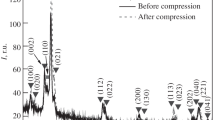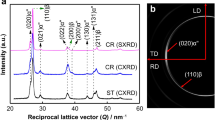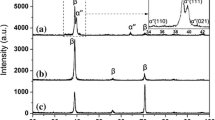Abstract
Superelastic alloys based on Ti–Zr–Nb are low-modulus biocompatible alloys for medical applications. We analyzed the regularities of the development of martensitic transformations (MT) β (bcc) → α′′ (orthorhombic lattice) in Ti–(17–19)Zr–(14–15)Nb (at.%) alloys, where α′′-phase arises under the influence of tensile or compressive stress. The crystallographic texture of β-titanium alloys was well studied. However, this is precisely what determines the recoverable strain in the material. Phase analysis using synchrotron radiation showed that the MT begins at 1% deformation, and at 1.5% the martensite lines are clearly distinguishable. The orientational dependences of the formation of domains of the martensite phase were studied using generalized direct pole figures. The main texture components of the cold rolled up to 97% and then recrystallized foils are {221}〈114〉 and {100}〈011〉. Under tensile deformation up to 1.4%, α′′-phase domains with the orientation (100)[001] is formed from β-grains compressed along the normal direction of the foil. With an increase in the degree of deformation to 1.6%, in addition to the main texture component, the second texture component appears. Its orientation depends on the direction of application of the external stress: (001)[110] in tension along the rolling direction and (\(\overline{1 }\)05)[501] in tension in the transverse direction.










Similar content being viewed by others
Data Availability
The data required to reproduce these findings are available to download from [43].
References
Ramezannejad A, Xu W, Xiao WL, Fox K, Liang D, Qian M (2019) New insights into nickel-free superelastic titanium alloys for biomedical applications. Curr Opin Solid State Mater Sci 23(6):100783. https://doi.org/10.1016/J.COSSMS.2019.100783
Miyazaki S, Miyazaki S (2017) My experience with Ti–Ni-based and Ti-based shape memory alloys. Shape Mem Superelast 3(4):279–314. https://doi.org/10.1007/s40830-017-0122-3
Yoneyama T, Miyazaki S (2009) Shape memory alloys for biomedical applications. Woodhead Publishing, England
Nuss S, US Patent no. 7.468.045 (2008)
Nordberg GF, Gerhardsson L, Broberg K, Mumtaz M, Ruiz P, Fowler BA (2007) Interactions in metal toxicology. Handb Toxicol Met, pp 117–145. https://doi.org/10.1016/B978-012369413-3/50062-8
Biocompatibility and tissue reaction to biomaterials. Craig’s Restor Dent Mater, pp 109–133 (2012) https://doi.org/10.1016/B978-0-323-08108-5.10006-4
Köster R, Vieluf D, Kiehn M, Sommerauer M, Kahler J, Baldus S, Meinertz T, Hamm CW (2000) Nickel and molybdenum contact allergies in patients with coronary in-stent restenosis. Lancet 356(9245):1895–1897. https://doi.org/10.1016/S0140-6736(00)03262-1
Kim HY, Hashimoto S, Il KJ, Hosoda H, Miyazaki S (2004) Mechanical properties and shape memory behavior of Ti-Nb alloys. Mater Trans 45(7):2443–2448. https://doi.org/10.2320/matertrans.45.2443
Kim HY, Miyazaki S (2016) Several issues in the development of Ti–Nb-based shape memory alloys. Shape Mem Superelast 2(4):380–390. https://doi.org/10.1007/s40830-016-0087-7
Bedi RS, Beving DE, Zanello LP, Yan Y (2009) Biocompatibility of corrosion-resistant zeolite coatings for titanium alloy biomedical implants. Acta Biomater 5(8):3265–3271. https://doi.org/10.1016/j.actbio.2009.04.019
Kim H-S, Kim W-Y, Lim S-H (2006) Microstructure and elastic modulus of Ti-Nb-Si ternary alloys for biomedical applications. Scr Mater 54(5):887–891. https://doi.org/10.1016/j.scriptamat.2005.11.001
Hao YL, Zhang ZB, Li SJ, Yang R (2012) Microstructure and mechanical behavior of a Ti-24Nb-4Zr-8Sn alloy processed by warm swaging and warm rolling. Acta Mater 60(5):2169–2177. https://doi.org/10.1016/j.actamat.2012.01.003
Kim HY, Sasaki T, Okutsu K, Kim JI, Inamura T, Hosoda H, Miyazaki S (2006) Texture and shape memory behavior of Ti-22Nb-6Ta alloy. Acta Mater 54(2):423–433. https://doi.org/10.1016/j.actamat.2005.09.014
Sun F, Nowak S, Gloriant T, Laheurte P, Eberhardt A, Prima F (2010) Influence of a short thermal treatment on the superelastic properties of a titanium-based alloy. Scr Mater 63(11):1053–1056. https://doi.org/10.1016/j.scriptamat.2010.07.042
Zhang J, Sun F, Hao Y, Gozdecki N, Lebrun E, Vermaut P, Portier R, Gloriant T, Laheurte P, Prima F (2013) Influence of equiatomic Zr/Nb substitution on superelastic behavior of Ti-Nb-Zr alloy. Mater Sci Eng A 563:78–85. https://doi.org/10.1016/j.msea.2012.11.045
Miyazaki S, Kim HY, Hosoda H (2006) Development and characterization of Ni-free Ti-base shape memory and superelastic alloys. Mater Sci Eng A 438–440:18–24. https://doi.org/10.1016/j.msea.2006.02.054
Ramarolahy A, Castany P, Prima F, Laheurte P, Péron I, Gloriant T (2012) Microstructure and mechanical behavior of superelastic Ti-24Nb-0.5O and Ti-24Nb-0.5N biomedical alloys. J Mech Behav Biomed Mater 9:83–90. https://doi.org/10.1016/j.jmbbm.2012.01.017
Fukui Y, Inamura T, Hosoda H, Wakashima K, Miyazaki S (2004) Mechanical properties of a Ti-Nb-Al shape memory alloy. Mater Trans 45(4):1077–1082. https://doi.org/10.2320/matertrans.45.1077
Kim HY, Fu J, Tobe H, Il KJ, Miyazaki S (2015) Crystal structure, transformation strain, and superelastic property of Ti–Nb–Zr and Ti–Nb–Ta Alloys. Shape Mem Superelast 1(2):107–116. https://doi.org/10.1007/s40830-015-0022-3
Fu J, Yamamoto A, Kim HY, Hosoda H, Miyazaki S (2015) Novel Ti-base superelastic alloys with large recovery strain and excellent biocompatibility. Acta Biomater 17:56–67. https://doi.org/10.1016/J.ACTBIO.2015.02.001
Cai S, Daymond MR, Ren Y, Schaffer JE (2013) Evolution of lattice strain and phase transformation of β III Ti alloy during room temperature cyclic tension. Acta Mater 61(18):6830–6842. https://doi.org/10.1016/J.ACTAMAT.2013.07.062
Kim HY, Ikehara Y, Kim JI, Hosoda H, Miyazaki S (2006) Martensitic transformation, shape memory effect and superelasticity of Ti-Nb binary alloys. Acta Mater 54(9):2419–2429. https://doi.org/10.1016/j.actamat.2006.01.019
Inamura T, Shimizu R, Kim HY, Miyazaki S, Hosoda H (2016) Optimum rolling ratio for obtaining {001}〈110 〉 recrystallization texture in Ti-Nb-Al biomedical shape memory alloy. Mater Sci Eng C 61(April):499–505. https://doi.org/10.1016/j.msec.2015.12.086
Zaripova MM, Isaenkova MG, Perlovich YA, Osintsev AV, Fesenko VA (2019) Influence of crystallographic texture and phase composition on the effect of superelastiñity of foils from alloys based on Ti-Nb. Chelyabinsk Phys Math J. https://doi.org/10.24411/2500-0101-2019-14109
Zaripova MM, Isaenkova MG, Fesenko VA, Osintsev AV (2021) The influence of the crystallographic texture and phase composition of Ti-Nb-Zr alloys with shape memory and superelasticity on their functional properties. IOP Conf Ser Mater Sci Eng 1121(1):012032. https://doi.org/10.1088/1757-899x/1121/1/012032
Isaenkova MG, Perlovich YA, Fesenko VA, Zaripova MM (2019) Orientation dependence of functional properties of alloys with shape memory effect and superelasticity. Chelyabinsk Phys Math J. https://doi.org/10.24411/2500-0101-2019-14209
Kim HY, Miyazaki S (2018) Chapter 4—Thermomechanical treatment and microstructure control. In: Kim HY, Miyazaki S (eds) Ni-free Ti-based shape memory alloys. Butterworth-Heinemann, Oxford, pp 111–145
Hasan M, Schmahl WW, Hackl K, Heinen R, Frenzel J, Gollerthan S, Eggeler G, Wagner M, Khalil-Allafi J, Baruj A (2008) Hard X-ray studies of stress-induced phase transformations of superelastic NiTi shape memory alloys under uniaxial load. Mater Sci Eng A 481–482:414–419. https://doi.org/10.1016/J.MSEA.2007.02.156
Zheng QS, Liu Y (2002) A Prediction of the detwinning anisotropy in textured NiTi shape memory alloy. Philosoph Mag. https://doi.org/10.1080/01418610208243195
Yang Y, Castany P, Cornen M, Prima F, Li SJ, Hao YL, Gloriant T (2015) Characterization of the martensitic transformation in the superelastic Ti-24Nb-4Zr-8Sn alloy by in situ synchrotron X-ray diffraction and dynamic mechanical analysis. Acta Mater 88:25–33. https://doi.org/10.1016/j.actamat.2015.01.039
Svetogorov RD, Sulyanov SN (2018) High-resolution powder diffraction at the XSA beamline of the Kurchatov Synchrotron Radiation Source. In: IX National crystal chemical conference, Suzdal, conference proceedings 81.
Svetogorov RD, Dionis—diffraction open integration software. Certificate of registration № 2018660965.
Perlovich YA, Isaenkova MG (2015) Strukturnaya neodnorodnost’ teksturirovannykh metallicheskikh materialov (Structural heterogeneity of textured metal materials). National Research Nuclear University MEPhI, Moscow, 398, In Russ.
Perlovich Y, Isaenkova M, Bunge HJ (2001) The fullest description of the structure of textured metal materials with generalized pole figures: the example of rolled Zr alloys. Mater Sci Forum 378–381:180–185. https://doi.org/10.4028/www.scientific.net/MSF.378-381.180
Perlovich Y, Isaenkova M (2002) Distribution of c- and a-dislocations in tubes of Zr alloys. Metall Mater Trans A. https://doi.org/10.1007/s11661-002-0156-8
Perlovich Yu, Isaenkova M (2005) Distribution of dislocation density in tubes from Zr-based alloys by X-ray data. Solid State Phenom 105:89–94. https://doi.org/10.4028/3-908451-09-4.89
Perlovich Yu, Isaenkova M (1997) Features of the phase transformations in sheets, tubes and welding seams of the alloy Zr-2.5%Nb. Text Microstruct 30:55–70. https://doi.org/10.1155/TSM.30.55
Fesenko V, Perlovich Y, Isaenkova M (2015) The increased shape memory effect in rolled Ti-48%Ni-2%Fe single crystals. Mater Today Proc 2:S751–S754. https://doi.org/10.1016/J.MATPR.2015.07.391
Perlovich Y, Isaenkova M (2011) Non-uniform strain hardening of crystallites within different regions of texture maxima: evidences and mechanisms. Mater Sci Forum 702–703:681–684. https://doi.org/10.4028/www.scientific.net/MSF.702-703.681
Perlovich Yu, Isaenkova M, Fesenko V (2008) Three laws of substructure anisotropy of textured metal materials, revealed by X-ray method of generalized pole figures. Mater Proces Text Ceram Trans 200:539–546. https://doi.org/10.1002/9780470444214.ch20
Perlovich Y, Isaenkova M, Bunge HJ, Fesenko V (2000) Distribution of residual microstresses in rolled textured metal materials. Mater Sci Forum 347–349:291–296. https://doi.org/10.4028/www.scientific.net/MSF.347-349.291
MTEX Toolbox (Electronic resource). https://mtex-toolbox.github.io/index.html. Accessed 19 Nov 2021
Zaripova M (2021) Phase and texture analysis data Mendeley Data, V1. https://doi.org/10.17632/2vmgssbt7f.1
Acknowledgements
The work was carried out with the financial support of the Russian Federation represented by the Ministry of Science and Higher Education of the Russian Federation (Agreement No. 075-15-2021-1352).
Author information
Authors and Affiliations
Corresponding author
Additional information
Publisher's Note
Springer Nature remains neutral with regard to jurisdictional claims in published maps and institutional affiliations.
Rights and permissions
About this article
Cite this article
Zaripova, M., Fesenko, V., Krymskaya, O. et al. Change in the Crystallographic Texture of the Martensitic Phase in Superelastic Ti–Zr–Nb Alloys with Increasing Tensile Strain. Shap. Mem. Superelasticity 8, 188–199 (2022). https://doi.org/10.1007/s40830-022-00383-0
Received:
Revised:
Accepted:
Published:
Issue Date:
DOI: https://doi.org/10.1007/s40830-022-00383-0




